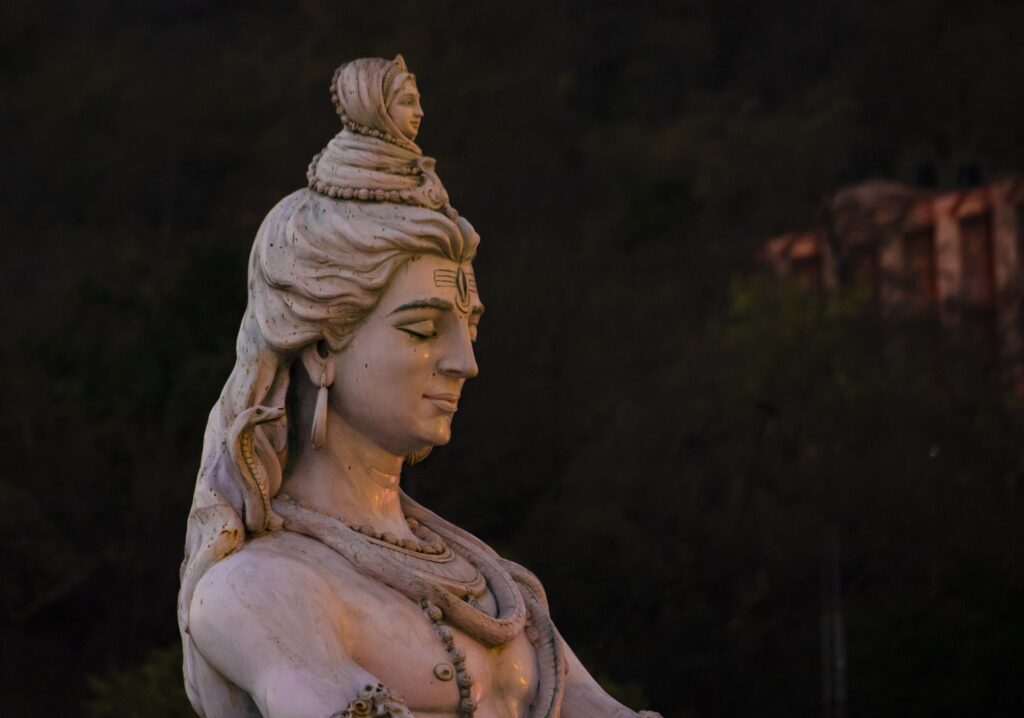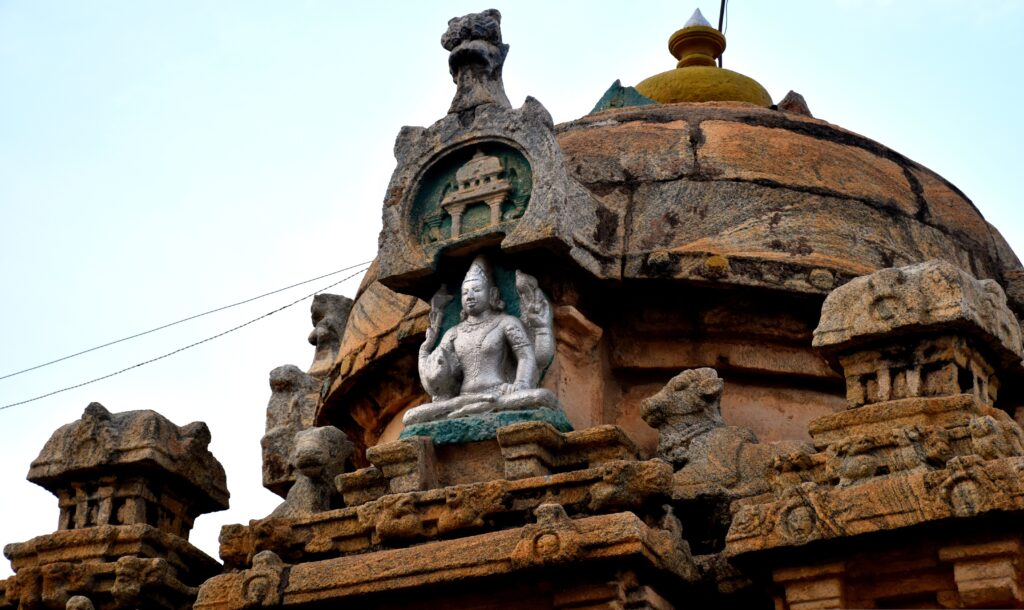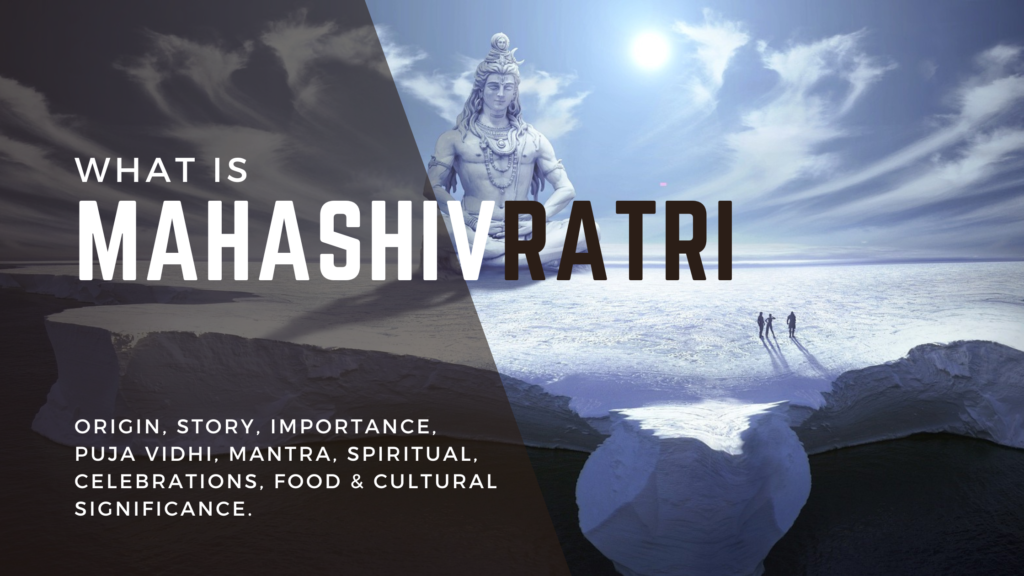Mahashivratri – the night of the almighty Lord Shiva, is not just any ordinary night! It is a night of extraordinary spiritual significance and fervor. On this night, the earth is said to be buzzing with an incredible surge of energy. It aligns with unique planetary positions. The devotees of Shiva celebrate this auspicious occasion with great zeal. They immerse themselves in the worship of the almighty Shiva, seeking blessings and undergoing a spiritual transformation. So gear up, light up the Diyas, offer milk and honey to the Shiva Lingam, and get ready to witness the magic of this Great Night of Shiva!
Meaning
Maha Shivaratri – it’s a name that’s as captivating as the festival itself! It’s a special occasion in the Indian faith, celebrated to honor Lord Shiva, the God of destruction. The name “Maha Shivaratri” is derived from the Sanskrit words “maha” (meaning great), “Shiva” (referring to the deity), and “ratri” (meaning night). So, put it all together; it refers to “the great night of Shiva”! It’s a time when devotees immerse themselves in prayer and worship. They seek blessings and spiritual transformation from the mighty lord of destruction.
Did you know that Lord Shiva is not just a God of destruction but also a prime yoga teacher? He’s known as Adiyogi or Adi Guru and is considered the first yogi of all time. That’s why many yoga practitioners worldwide celebrate Maha Shivaratri to honor the great yogi who blessed humanity with the gift of yoga. It’s a time to reflect on the practice’s spiritual significance and pay homage to the original teacher who laid the foundation of this transformative art.
Origins and Legends (Story)
It is a festival steeped in legends and stories that are as mesmerizing as they are mysterious! One such tale is the story of Samudra Manthan, which tells the tale of Lord Shiva drinking the poison that emerged from the churning of the cosmic ocean and saving the universe. Another legend is the divine marriage of Lord Shiva and Parvati celebrated as a symbol of love and devotion. There’s also the legend of Shiva’s Tandava dance, symbolizing creation, preservation, and destruction. And if that’s not enough, let’s not forget the story of the demon Tripurasura, defeated by Lord Shiva on this day, signifying the triumph of good over evil. It’s a festival full of magic and wonders, with each legend adding to the richness of the occasion. So, experience the mystique!
Date and Time
Mahashivratri 2023 is on 18th February. In the Hindu calendar month, Phalunga or Maagh, Maha Shivaratri occurs from the 13th night to the 14th day (February or March).
Did you know a smaller version of the Maha Shivaratri celebration occurs monthly? It’s called Shivaratri, which happens the day before the new moon. But, the most significant celebration is the Maha Shivaratri, which takes place in February or March. On this night, the natural energy of the universe is at its peak. Hence, the festival is observed to harness this energy. The festival is night long. One of the fundamental practices is to remain awake with your spine upright throughout the night to allow the energy to flow freely.
Shivratri is celebrated on the darkest night of every month. But, the celebration of Mahashivratri is not about darkness but about embracing the concept of “that which is not.” This is the essence of Lord Shiva, who represents the vast emptiness of existence beyond creation. By celebrating Mahashivratri, we celebrate the presence of this emptiness at the core of existence.
Importance
Mahashivratri is a very important day for those on a spiritual path, those in family situations, and the ambitious in the world. For those in family situations, it is seen as Shiva’s wedding anniversary, and for the ambitious, it is the day Shiva conquered all his enemies. But for ascetics, it is the day he became one with Mount Kailash, becoming utterly still like a mountain.

- In the yogic tradition, Shiva is not worshipped as a God but as the first Guru from whom the science of Yoga originated. After many millennia in meditation, he became still, and that day is Mahashivratri, the night of stillness. This day is important because it presents possibilities to a spiritual seeker.
- Modern science has proven that everything in the world is just one energy that manifests itself in many ways. This fact is an experiential reality for every yogi. Yoga is the longing to know the oneness in existence. The night of Mahashivratri offers a person the opportunity to experience this.
- Every religion and culture on this planet has talked about the omnipresent, all-pervading nature of the divine, and darkness, nothingness, or emptiness is the only thing that can truly be all-pervading. Therefore, the divine is referred to as light when people seek well-being. Still, when they look beyond their life in terms of dissolving, the object of their worship and sadhana is dissolution. The divine is referred to as darkness.
- Shiva is the vast emptiness within every human being, the source of all creation.
- Shiva is the destroyer, most compassionate, and greatest giver. The yogic lore is filled with stories of Shiva’s compassion, and Mahashivratri is a special night for receiving.
Do not let this night pass without experiencing a moment of the vastness of this emptiness that we call Shiva. Let this night not just be a night of wakefulness but a night of awakening for you.
Mahashivratri Puja Vidhi
The ancient prayers of Indian culture have always focused on dissolving one’s limitedness and experiencing the unboundedness of the source of creation within each human being. What better time to do this than on the darkest night of the month? It’s when the veil between the physical and spiritual realms is thinnest.
During this special night, devotees chant mantras, offer prayers, and fast until the next morning. Many even stay up all night, singing devotional songs and keeping their spines erect to mimic the posture of Shiva as Adi Yogi. By doing so, they open the channels around the spine, allowing energy to surge upwards and expand their consciousness.
But Maha Shivaratri is not just about personal transformation. It is also a time to honor Lord Shiva, who represents the purest form of existence and consciousness. Yogis may design special sequences or devote their entire practice to Shiva to pay tribute to the ultimate yogi.
To perform the pooja vidhi during Maha Shivaratri, devotees typically wake up early and bathe before donning new clothes. They then visit the nearest Shiva temple to offer bilva leaves, milk, honey, and water to the Shivlinga, a representation of Shiva. Some devotees also pour milk and water over the Shivlinga as a symbol of purification.
Throughout the night, devotees continue to offer prayers and perform special rituals, such as the Rudra Abhishekam. It involves reciting mantras and offering milk and other items to the Shivlinga. The night is filled with singing and dancing as devotees celebrate Lord Shiva’s supreme consciousness.
In essence, Maha Shivaratri is a time to tap into the limitless potential of the human spirit and honor the ultimate embodiment of consciousness. By dissolving our limitations and opening ourselves to the divine energy of Lord Shiva, we can awaken to our true selves and experience the blissful essence of existence.
Mantra
At Mahashivratri, various mantras can be chanted depending on personal preference and tradition. Some of the mantras that are most frequently sung include:
- The potent chant “Om Namah Shivaya” is thought to summon Lord Shiva’s blessings. Therefore, it can be shouted constantly throughout any Shiva-related ritual or while meditating.
- This powerful chant, known as the “Maha Mrityunjaya Mantra,” is said to protect and heal the body and the mind. Therefore, it is frequently repeated to promote health and longevity and overcome hurdles and fear.
- The well-known Rudra Mantra, also known as the Mrita Sanjeevani Mantra, is “Om Trayambakam Yajamahe Sugandhim Pushtivardhanam.” This chant is thought to improve the spirit by purging the body of all sins, ailments, and negativity.
- Lord Rama, who is thought to be an incarnation of Lord Shiva, is invoked with the mantra “Om Shri Ramaya Namah.” It is thought to offer protection, bravery, and strength.
Mantras are potent instruments for spiritual practice, but their effectiveness depends on one’s sincerity, attention, and intention. Therefore, the finest mantra to use is one that speaks to you individually and should be chanted with complete devotion and faith.
Mahashivratri Celebration
Shiva devotees participate in several rites and practices on this day to purify their bodies and minds and establish a spiritual connection.

Fasting is among the most popular customs related to Mahashivratri. For the entire day, devotees fast from food and liquids as a measure of self-control and penance. This aids their mental and physical cleansing as they prepare for the day’s spiritual exercises.
Another significant ceremony performed on this day is offering milk and honey to the Shiva lingam. Offering milk and honey symbolizes one’s love and submission to Shiva since the Shiva lingam represents the embodiment of holy awareness.
An essential component of the celebrations is lighting lamps or diyas. On Mahashivratri, it is thought that lighting lamp wards off darkness and negativity and brings light and optimism into one’s life.
A key component of the festivities also includes mantra chanting and special prayers. The vibrations produced by the mantras are thought to have a strong impact on the mind and body and can facilitate a person’s connection to the divine and their attainment of inner tranquility and bliss.
Together with these customs, Mahashivratri is also enthusiastically observed by participating in cultural events, music, dance, and feasting. People conduct processions and parades in some regions of India while they perform traditional folk dances and sing devotional songs in other regions.
Ultimately, Mahashivratri is a celebration that honors the magnificence and strength of Lord Shiva and offers believers a chance to strengthen their faith, undergo inner change, and advance spiritually.
Food
Maha Shivaratri is a time for eating and indulging in unique treats in addition to acts of devotion and meditation. Therefore, devotees keep a stringent fast and refrain from eating grains, beans, and meat throughout this holiday. In its place, they eat special dishes that are made using fast-acceptable ingredients.
Sabudana Khichdi, a dish composed of tapioca pearls, peanuts, and potatoes, is a very well-liked dish served on this occasion. This meal supplies the required energy to keep the fast going while being light and simple to digest.
Vrat ke Chawal, another well-liked meal, is prepared using rice that is intended especially for fasting. Because it is not polished, this rice is healthier and more nutrient-rich than conventional rice because it still has the bran and germ.
The last special beverage drunk during Maha Shivaratri is called Thandai. Made with milk, sugar, almonds, and spices like cardamom, saffron, and pepper, it is a cold, sweet beverage. Not only is Thandai reviving and supplying the energy needed to keep the fast going.
Several traditional meals are created as part of the Maha Shivaratri celebrations, which strongly emphasize food. The meals are not just delectable; many of them are cooked as gifts to Lord Shiva, giving them a symbolic meaning in addition to their culinary appeal. These particular delicacies are made with love and care and are intended to satisfy the palate while sustaining the body during the fast.
Cultural Significance
Maha Shivaratri is a celebration that transcends religion. It is a celebration of the divine that draws people together and unites them. The manner in which Maha Shivaratri is observed in various regions of India demonstrates its cultural significance.
Maha Shivaratri is commemorated in several regions of the nation through traditional dances like the Garba in Gujarat and the Thiruvathira in Kerala. The Garba is an elegant and exuberant dance in front of an illuminated Shiva statue or lamp. A women’s dance, the Thiruvathira, is done in a circle around a lamp. These dances serve as a platform for communal celebration and a statement of devotion.
Maha Shivaratri is enthusiastically observed in Maharashtra. Fasting is observed, and prayers are offered to Lord Shiva. To commemorate the deity, they also dance the “Gondhal” and “Jogwa,” two traditional folk dances. Special foods like “Sabudana Khichdi” and “Kheer” are cooked to break the fast.
Ultimately, Maha Shivaratri is a time for people to unite in joy and celebration of the holy. It serves as a reminder of the value of community and the strength of devotion.
Several traditional songs are sung in the worship of Lord Shiva during Maha Shivaratri, a music festival. However, the “Om Namah Shivaya” chant, considered a potent mantra that can help people connect with the divine, is one of the most well-known melodies.
Conclusion
Maha Shivaratri is not just another Hindu celebration; rather, it represents a potent chance for us to rise above the bounds of our ignorance and discover the true essence of the cosmos and ourselves. This moment is when Shiva, the destroyer and provider, reminds us of his compassionate side. Destroying something is not the end but rather a method to give birth to something greater and newer.
The way the festival is observed—fasting, special prayers, milk and honey offerings to the Shiva Lingam, lighting diyas, and mantra chanting—reflects Shiva’s benevolent nature. These exercises are designed to assist devotees in letting go of their egos, submitting to the divine, and uniting with the universe.
We can try to remove the layers of ignorance and attachment that keep us from perceiving the world as it is through these rituals. It’s important to remember that Shiva is also a giver who helps us become more alert and aware of our surroundings. Therefore let us embrace the divine on this auspicious day of Maha Shivaratri and allow ourselves to be led towards a more kind and awakened existence.
Frequently Asked Questions (FAQs)
The daylong chanting of “Om Namah Shivaya,” Shiva’s revered Panchakshari mantra, can be heard in Shiva temples. With the chanting of the hymn known as the Shiv Chalisa, devotees extol Shiva. According to the Hindu lunisolar calendar, Maha Shivaratri is observed over three or 10 days. Most individuals observe Mahashivratri at home, where they pray, meditate, and celebrate.
A natural spike in energy occurs in a person on this night because the earth’s northern hemisphere is in a certain position. So, a serious Hindu celebration stands out for its introspective focus, fasting, Shiva meditation, self-study, societal harmony, and an all-night vigil at Shiva temples. This is in contrast to most Hindu festivals, which also have expressions of cultural festivity.
Mahashivratri is a time for meditation, chanting, fasting, and prayer. On the Mahashivratri night, devotees frequently make an effort to avoid sleeping. This is because a natural influx of energy occurs in the human body at night. Only people with vertical, straight spinal cords or spines can utilize this magnificent energy.
You may enjoy reading other blissful articles here-

